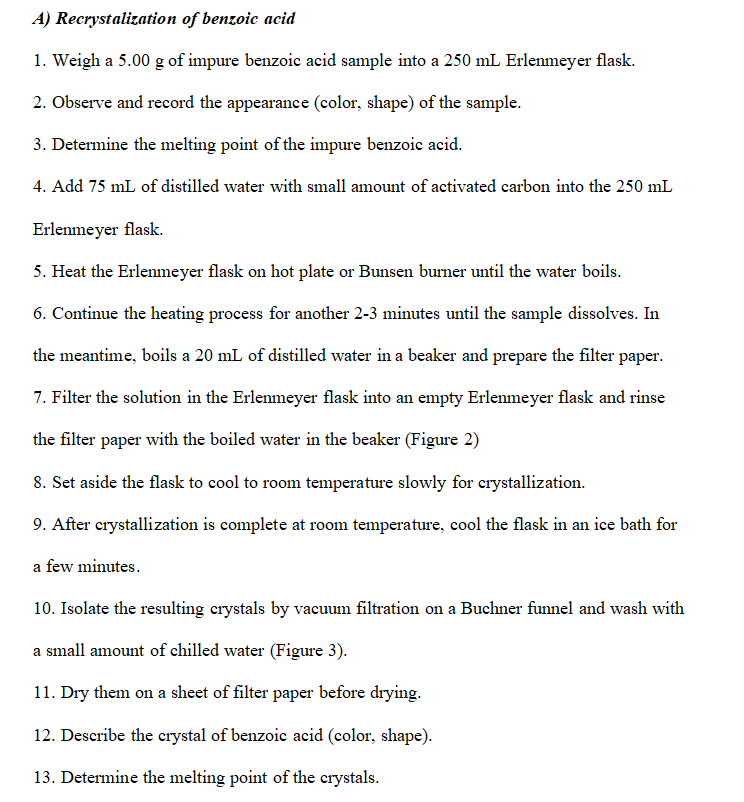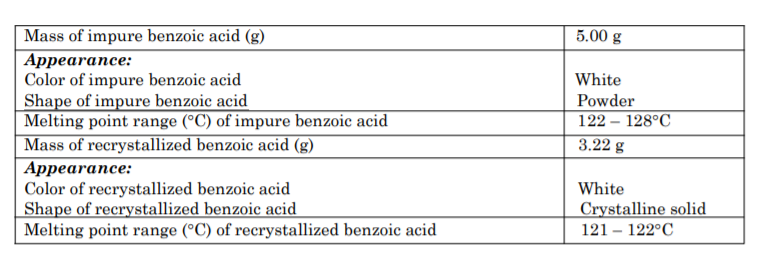Experiment : Purification of Benzoic Acid by recrystallization process . Explain the result that obtain.
Experiment : Purification of Benzoic Acid by recrystallization process . Explain the result that obtain.
Introduction to Chemical Engineering Thermodynamics
8th Edition
ISBN:9781259696527
Author:J.M. Smith Termodinamica en ingenieria quimica, Hendrick C Van Ness, Michael Abbott, Mark Swihart
Publisher:J.M. Smith Termodinamica en ingenieria quimica, Hendrick C Van Ness, Michael Abbott, Mark Swihart
Chapter1: Introduction
Section: Chapter Questions
Problem 1.1P
Related questions
Question
Experiment : Purification of Benzoic Acid by recrystallization process .
Explain the result that obtain.

Transcribed Image Text:A) Recrystalization of benzoic acid
1. Weigh a 5.00 g of impure benzoic acid sample into a 250 mL Erlenmeyer flask.
2. Observe and record the appearance (color, shape) of the sample.
3. Determine the melting point of the impure benzoic acid.
4. Add 75 mL of distilled water with small amount of activated carbon into the 250 mL
Erlenmeyer flask.
5. Heat the Erlenmeyer flask on hot plate or Bunsen burner until the water boils.
6. Continue the heating process for another 2-3 minutes until the sample dissolves. In
the meantime, boils a 20 mL of distilled water in a beaker and prepare the filter paper.
7. Filter the solution in the Erlenmeyer flask into an empty Erlenmeyer flask and rinse
the filter paper with the boiled water in the beaker (Figure 2)
8. Set aside the flask to cool to room temperature slowly for crystallization.
9. After crystallization is complete at room temperature, cool the flask in an ice bath for
a few minutes.
10. Isolate the resulting crystals by vacuum filtration on a Buchner funnel and wash with
a small amount of chilled water (Figure 3).
11. Dry them on a sheet of filter paper before drying.
12. Describe the crystal of benzoic acid (color, shape).
13. Determine the melting point of the crystals.

Transcribed Image Text:Mass of impure benzoic acid (g)
5.00 g
Аppearance:
Color of impure benzoic acid
Shape of impure benzoic acid
Melting point range (°C) of impure benzoic acid
Mass of recrystallized benzoic acid (g)
Аppearance:
Color of recrystallized benzoic acid
Shape of recrystallized benzoic acid
Melting point range (°C) of recrystallized benzoic acid
White
Powder
122 – 128°C
3.22 g
White
Crystalline solid
121 – 122°C
Expert Solution
This question has been solved!
Explore an expertly crafted, step-by-step solution for a thorough understanding of key concepts.
Step by step
Solved in 2 steps

Knowledge Booster
Learn more about
Need a deep-dive on the concept behind this application? Look no further. Learn more about this topic, chemical-engineering and related others by exploring similar questions and additional content below.Recommended textbooks for you

Introduction to Chemical Engineering Thermodynami…
Chemical Engineering
ISBN:
9781259696527
Author:
J.M. Smith Termodinamica en ingenieria quimica, Hendrick C Van Ness, Michael Abbott, Mark Swihart
Publisher:
McGraw-Hill Education

Elementary Principles of Chemical Processes, Bind…
Chemical Engineering
ISBN:
9781118431221
Author:
Richard M. Felder, Ronald W. Rousseau, Lisa G. Bullard
Publisher:
WILEY

Elements of Chemical Reaction Engineering (5th Ed…
Chemical Engineering
ISBN:
9780133887518
Author:
H. Scott Fogler
Publisher:
Prentice Hall

Introduction to Chemical Engineering Thermodynami…
Chemical Engineering
ISBN:
9781259696527
Author:
J.M. Smith Termodinamica en ingenieria quimica, Hendrick C Van Ness, Michael Abbott, Mark Swihart
Publisher:
McGraw-Hill Education

Elementary Principles of Chemical Processes, Bind…
Chemical Engineering
ISBN:
9781118431221
Author:
Richard M. Felder, Ronald W. Rousseau, Lisa G. Bullard
Publisher:
WILEY

Elements of Chemical Reaction Engineering (5th Ed…
Chemical Engineering
ISBN:
9780133887518
Author:
H. Scott Fogler
Publisher:
Prentice Hall


Industrial Plastics: Theory and Applications
Chemical Engineering
ISBN:
9781285061238
Author:
Lokensgard, Erik
Publisher:
Delmar Cengage Learning

Unit Operations of Chemical Engineering
Chemical Engineering
ISBN:
9780072848236
Author:
Warren McCabe, Julian C. Smith, Peter Harriott
Publisher:
McGraw-Hill Companies, The